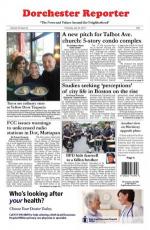September 1, 2011
Hurricanes are sometime things for Boston and its neighborhoods and that surely is a good thing. But when “sometime” happens, the stormy wrath is a sight to behold.
Calamity Irene, our most recent visitor, mostly spared our region from the awesome destruction of a Katrina (New Orleans 2005) or an Andrew (Florida 1992) or a Hugo (the Carolinas 1989), though to say that isn’t any comfort if you are without power four days later, as some towns are, or if you had a tree fall on your car or against your house, as some folks had happen in Dorchester and environs.
By Tuesday, talk radio and the blog-blabbers were at their querulous best with their witless after-the-fact blathering against forecasters and public officials who, they decided, had missed the boat badly on the seriousness of the threat posed to us by Irene as the tropical storm moved up the Atlantic coast over the weekend.
With respect to nature and its hurricanes, the largest storms on the earth, “seriousness” is all about where you are when the winds pick up and the rain begins to fall. And Irene, whose waters and wind have devastated cities and towns from North Carolina to the Berkshires and through the bountiful hills of Vermont and upstate New York, will remain legendary there long after order has been restored to those communities.
The National Weather Service and its affiliated acolytes on local television and radio outlets who track these disasters-in-the-making deserve our deepest thanks for giving us their considered professional judgment as to what to expect virtually minute by minute. We are always the better for that information even when a frightful storm throws a curve ball at the forecasters by toning down the winds some for a while or by lurching to the next state over on its way north and away from us.
The richness of forecasting today, even with its variables, reminds some of us of a time in our lives some 60 years or so when hurricanes came at us with nary a minute’s warning. On Tues., Aug. 31, 1954, my brother and I were assigned to be the altar boys at the 6:45 a.m. Mass at St. Mark’s Church. In those days, altar servers had to wear a sort-of uniform – a stiff white collar with collar buttons and a cape and surplice over our shoulders – and we carried our vestments to church in small suitcases.
As Skip and I left the house about 6:30 for the two-block walk from Lonsdale Street to the church, the wind was howling and the rain was coming down in sheets. But we pressed on, unknowingly, and when I turned the corner onto the Avenue at Ogar’s Drug Store, my suitcase snapped open and the vestments flew off behind me toward Shepton Street never to be seen again.
Hello, Carol, we weren’t expecting you.
That hurricane hit New England unannounced (most forecasts called, simply, for “rain”), making landfall in southeastern Connecticut with sustained winds of 80 to 100 mph, and gusts that reached 135 mph on Block Island. According to the National Weather Service, Carol destroyed nearly 4,000 homes, along with 3,500 automobiles, and over 3,000 boats in southern New England. All of Rhode Island, much of eastern Connecticut, and much of eastern Massachusetts lost electrical power, many sections for days. In addition, as much as 95 percent of all phone power was interrupted in these locations for varying amounts of time. And, unlike last weekend, who knew the night before?
Weather historians note that hurricanes seem to come to us in bunches of years, and the stretch between 1954 and 1972, when accurate hurricane-track prediction was a work in progress, saw numerous tropical storms roughly work over East Coast cities and towns. If we are in for another such series of blows, I’ll take our forecasters’ word for it every time out, and make ready.
Tom Mulvoy, a Dorchester native, is associate editor of the Reporter and a former managing editor of the Boston Globe.


